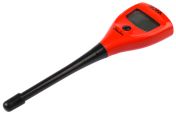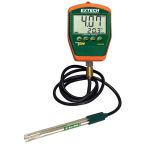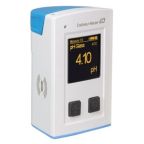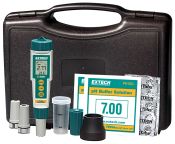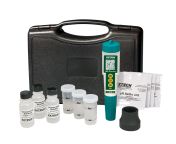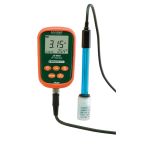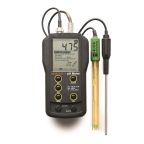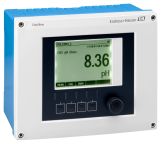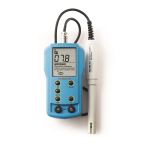pH Meters
A pH meter is an instrument designed to measure the hydrogen-ion level in water based solutions. A pH meter indicates the acidity and alkalinity and is sometimes also referred to as a potentiometric pH meter. A pH meter works by measuring the voltage between two electrodes. The results are displayed by converting this information into a pH value.
The term 'pH' refers to a unit of measure with a range between zero and fourteen. The mathematical symbol 'p' represents potential, while the 'H' is the symbol for hydrogen. For more information, check out our pH meters guide.
RS offers a comprehensive range of pH meters from leading brands such as Endress+Hauser, FLIR, Testo, Hanna Instruments and RS PRO. These pH meters cater to various needs, from basic testing to advanced applications, ensuring precise and reliable measurements of acidity and alkalinity. RS provides both portable and benchtop models, suitable for field and laboratory use. Additionally, RS offers calibration services to maintain the accuracy and performance of your pH meters, ensuring compliance with industry standards and providing peace of mind for your testing requirements
Applications
- Harsh environments
- Biological micro-environments
- Laboratory experimentation
- Quality control
- Agriculture
- Municipal water supplies
- Brewing industry
- Swimming pools
- Food industry
What types of meters are there?
- Pocket testers are a device with an LCD display which can deliver fast and accurate readings. They are lightweight and easy to transport making them ideal for field use. Pocket tester meters are popular with students and researchers which they use for measurements in test tubes and vials. Features of a pocket tester meter include automatic buffer recognition, easily replaceable electrodes and thousands of hours of battery life.
- Portable pH meters are handheld and lightweight. They contain Bluetooth technology which allows the information to be downloaded to a mobile or tablet. Multi-parameter meters are suited to robust industrial environments and have PC connectivity.
- Bench meters are accurate, easy to use and available with Bluetooth technology and built-in printers. It is easy to transfer data via Bluetooth onto a mobile or tablet, or onto a PC via a USB cable.
- Test kits measure the strength or weakness of a chemical presence by the degree of colour saturation. If pale then the concentration is low, if strong then the concentration is high. Adding the reagent to the compound allows the colour to be tested against a colour chart.
- pH test strips are small, disposable strips of paper that change colour when dipped into a solution, indicating the acidity or alkalinity (pH level) of the solution. They are useful for quick, low-cost testing, making them ideal for general use in laboratories, educational settings, and various home applications. However, for more accurate and precise measurements, pH meters are preferred as they provide higher accuracy and reliability.
Replacement parts are available, such as pH probes made from a special glass composed of alkali metal ions which sense the hydrogen ion concentration. As the electrode ages, the glass electrodes resistance changes.
pH meter calibration is required as electrodes run down eventually and need to be calibrated on a regular basis. Calibration in a pH buffer solution which has a constant pH value should always start with buffer 7.0 as this is point 'zero'. The pH scale has an equivalent mV scale from +420 mV to -420 mV. The buffer solution is available as a pre-mixed liquid or dry powder capsules.
Popular Searches
Related links
- A Complete Guide to pH Meters
- Hanna Instruments HI 98201 pH Meter
- Hanna Instruments CHECKER1 pH Meter 0.1pH Resolution, 14pH Max
- Hanna Instruments HI 98130 pH Meter 0.01pH Resolution +60 °C Max
- Hanna Instruments HI-9812-51 pH Meter 0.1pH Resolution +70 °C Max
- Hanna Instruments HI 98129 pH Meter 0.01pH Resolution +60 °C Max
- Hanna Instruments HI 991300 pH Meter 0.01pH Resolution +60 °C Max
- Hanna Instruments HI 991001N pH Meter 0.01pH Resolution +105 °C Max
